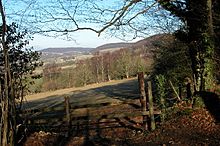Bull Cross, The Frith and Juniper Hill facts for kids
| Site of Special Scientific Interest | |

The Frith
|
|
| Area of Search | Gloucestershire |
|---|---|
| Coordinates | 51°46′25″N 2°11′10″W / 51.773674°N 2.186189°W |
| Interest | Biological/Geological |
| Area | 42.33 hectare |
| Notification | 1954 |
Bull Cross, The Frith and Juniper Hill is a special natural area in Gloucestershire, England. It covers about 42 hectares, which is like 80 football fields! This area was officially protected in 1954 as a Site of Special Scientific Interest (SSSI). This means it's really important for its unique plants, animals, and rocks.
The site is located in the beautiful Cotswolds Area of Outstanding Natural Beauty. Part of it is common land, which means many people can use it. Another part is a nature reserve, looked after by the Gloucestershire Wildlife Trust. This trust helps protect the area's wildlife and habitats.
Contents
Exploring the Natural Wonders
This special area is made of different parts, each with its own unique features. It has old beech woodlands, grassy fields that haven't been changed by farming, and even old quarries. All these parts sit on Jurassic limestone rocks from the western Cotswolds.
Juniper Hill: A Home for Rare Plants
Juniper Hill has woodlands mostly filled with ash trees. You can also find yew trees and smaller plants like hazel and hawthorn. The ground is often covered with bramble and dog's mercury. In some parts, you might even see silver birch trees.
The grassy areas here are very natural. The main grass you'll see is upright brome. Other interesting plants include quaking grass, cock's foot, and cowslip. Many beautiful orchids grow here, like the musk orchid. However, some of these orchids are in danger from plants like hawthorn growing too much. You can also spot yew, whitebeam, and juniper trees scattered around.
Bull Cross: Grassy Fields and Flowers
The plants at Bull Cross are similar to those at Juniper Hill. It's another lovely area of natural grassland, though it might have a little less variety of plants.
The Frith: Ancient Beech Woodland
The Frith is mostly an ancient beech woodland, with about 80% of its trees being beech. You'll also find ash and whitebeam trees. Smaller plants like holly, yew, and hazel grow here, along with young beech and ash trees.
The ground is home to plants like bramble and sweet woodruff. If you're lucky, you might spot some rare plants such as white helleborine, broad-leaved helleborine, columbine, and common wintergreen. Other woodland flowers include lesser periwinkle, bluebell, yellow archangel, and early purple orchid. This wood is also famous for its many types of fungi and tiny creatures called molluscs.
Uncovering Ancient Rocks
Frith Quarry: A Window to the Jurassic Past
Frith Quarry is a very important place for geologists (scientists who study rocks). It shows us rocks from the Middle Jurassic period, which was millions of years ago when dinosaurs roamed the Earth! These rocks help scientists understand the "Inferior Oolite" rock layers in the Cotswolds.
Scientists have found amazing fossils here, including brachiopods and ammonites. These were ancient sea creatures that lived in the Jurassic seas. Finding ammonite fossils here is quite rare in the Cotswolds, making this site super important for learning about Earth's history.
Frith Wood Nature Reserve: A Special Place
Frith Wood is about three miles northeast of Stroud and is a well-known spot. It sits on top of a hill between the valleys of Painswick and Slad. This is a very old wood that became a Gloucestershire Wildlife Trust nature reserve in 1966. The trust bought the wood in 1987 with help from many different groups, like the National Heritage Memorial Fund and the World Wide Fund for Nature.
A Glimpse into the Past
The name 'Frith' comes from an old Saxon word meaning "wooded enclosure." This wood has probably been managed for a very long time, possibly since Saxon times. The tall beech trees you see today were planted after the Napoleonic Wars. The successful growth of these beech trees, along with all the plants and animals, makes this a great example of an ancient woodland in the Cotswolds.
In the mid-1700s, a special "Arcadian" garden called 'Pan's Lodge' was built in Frith Wood. It was dedicated to Pan, the Greek god of nature and pleasure. A painting from 1757 shows a small house overlooking the valley, surrounded by beautiful walks and planted trees. This area was even renamed Coldbourn Grove for a while. By the 1820s, the lodge had disappeared, and only a small mound remains today. Some of the old garden plants still grow in the woodland. There's also a small old quarry in Frith Wood, which might have been used to get stones for walls or even for Pan's Lodge.
An old road from Birdlip to Stroud used to go through Frith Wood Common until a new main road (now the B4070) was built in the 18th century.
Wildlife in the Wood
Frith Wood is home to many birds, including the wood warbler, marsh tit, and green woodpecker. You can also find special types of molluscs (like snails and slugs) that live in ancient woodlands. Hundreds of different kinds of fungus have been found in this reserve, making it a fantastic place for nature lovers.
Protecting the Woodland
Since 1960, the wood has been managed to help it grow naturally. This means carefully cutting down some older trees to allow younger ones to grow. They also control invasive trees like sycamore by removing them or by ringbarking them (removing a strip of bark) to create standing dead wood, which is good for wildlife.
Images for kids


